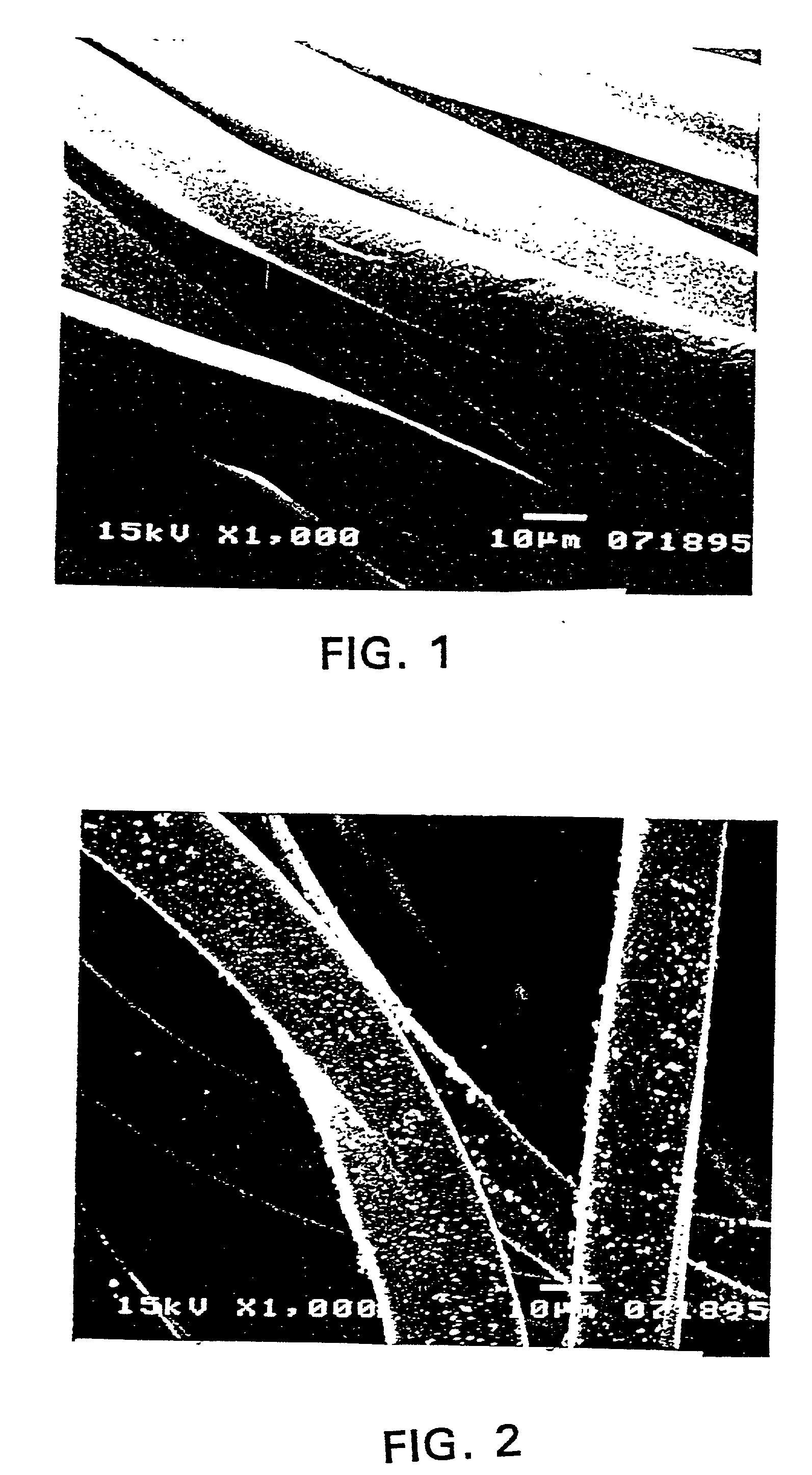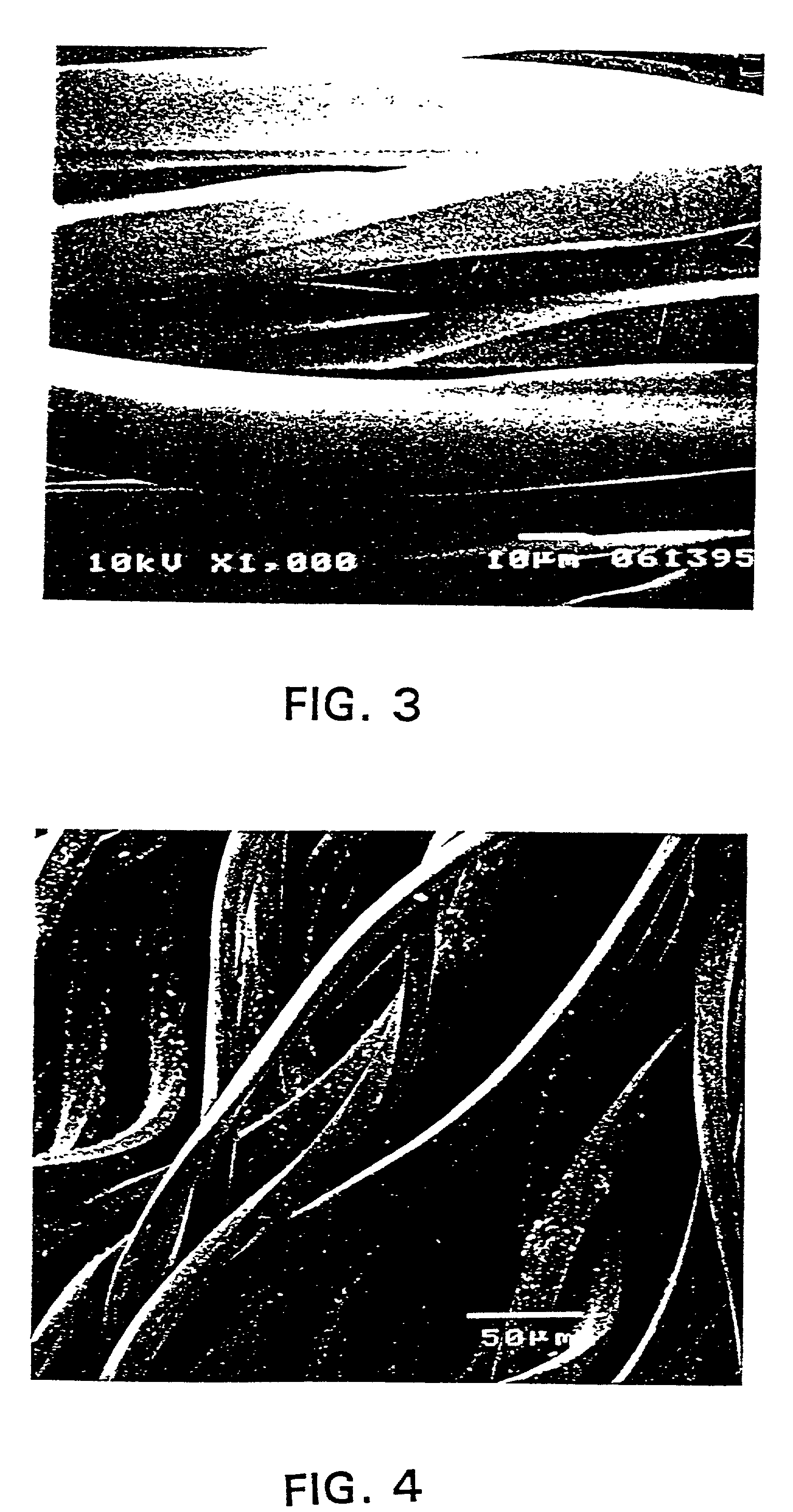Anti-static cleanroom products and methods of making same
a technology of anti-static cleanroom products and cleanroom products, applied in the direction of weaving, synthetic resin layered products, other chemical processes, etc., can solve the problems of increasing static electricity problems, affecting the production yield of reliable semiconductor devices, and affecting the safety of sparks, etc., to achieve uniform anti-static properties, simple and inexpensive to make and use, and the effect of simple structur
- Summary
- Abstract
- Description
- Claims
- Application Information
AI Technical Summary
Benefits of technology
Problems solved by technology
Method used
Image
Examples
example 1
50. 300 mL of deionized water was placed in a 1.5 L beaker. The beaker placed on the platform of an orbital shaker running at a speed of 150 rpm. 2.0 g of benzenesulfonic acid, sodium salt and 2.8 g of ferric chloride were slowly added into the beaker after both ingredients were predissolved separately in 50 mL water. Immediately after the additions, 0.5 g of neat pyrrole (non-diluted) was added dropwise into the beaker. While the shaker was still running, 12.2 g of polyester wiper material was added to the beaker. The total weight represented two 9".times.9" sealed-edge double-knit wipers constructed from 100 percent continuous filament textured polyester.
51. The reaction was run for two hours at room temperature. Initially the color of the white wipers changed to light yellow and then gradually changed to grayish black. At this stage, the wipers were taken out from the beaker and placed in a separate clean beaker. The wipers were then rinsed several times with deionized water cont...
example 2
53. To determine the contamination characteristics of the electrostatic discharge (ESD) dissipative wipers, additional wipers were produced using procedures similar to Example 1 with the following changes:
54. The steps in Example 1 were repeated except that the reaction was conducted in a clean stainless steel tray (size 113 / 4".times.91 / 2".times.-33 / 4"). The contamination characteristics such as particles, non-volatile residues, and ions, of the original wipers were determined by usual laboratory test procedures prior to coating. After the coating treatment, the same parameters were evaluated in order to determine the extent of any increase in contamination that may have occurred as a result of the process.
55. Accordingly, 800 mL of deionized water was placed in the steel tray. The tray was placed on the platform of the orbital shaker and the shaker was allowed to run at 150 rpm. Four grams of benzenesulfonic acid, sodium salt (predissolved in 100 mL water), five grams of ferric chl...
example 3
59. The procedure of Example 2 was repeated except the contents of the steel tray as shown in Example 2 were changed as follows:
60. a. 900 mL deionized water
61. b. 0.5 g of 2,6-Napthalenedisulfonic acid, disodium salt as the doping agent predissolved in 50 mL water
62. c. 0.5 g of Potassium persulfate as the oxidizing agent predissolved in 50 mL water
63. d. 1 mL of neat pyrrole added dropwise
64. e. and 4 pieces of 9".times.9"nylon wipers.
65. The reaction was run at room temperature. The entire content of the tray was allowed to shake on an orbital shaker for 30 minutes. The resultant products were grayish black wipers. The wipers were taken out and rinsed several times with deionized water containing surfactants and allowed to dry. The dried wipers were tested and found to be as clean as those prepared in Example 2, including a substantial reduction in chloride content. The resistivity was tested and determined to be in the range of 10.sup.+6 .OMEGA.. The chloride content in these wi...
PUM
| Property | Measurement | Unit |
|---|---|---|
| size | aaaaa | aaaaa |
| time | aaaaa | aaaaa |
| size | aaaaa | aaaaa |
Abstract
Description
Claims
Application Information
 Login to View More
Login to View More - R&D
- Intellectual Property
- Life Sciences
- Materials
- Tech Scout
- Unparalleled Data Quality
- Higher Quality Content
- 60% Fewer Hallucinations
Browse by: Latest US Patents, China's latest patents, Technical Efficacy Thesaurus, Application Domain, Technology Topic, Popular Technical Reports.
© 2025 PatSnap. All rights reserved.Legal|Privacy policy|Modern Slavery Act Transparency Statement|Sitemap|About US| Contact US: help@patsnap.com


